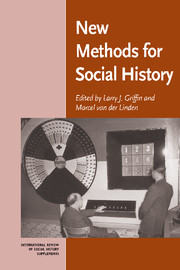Book contents
- Frontmatter
- Contents
- NOTES ON CONTRIBUTORS
- Introduction
- Temporally Recursive Regression and Social Historical Inquiry: An Example of Cross-Movement Militancy Spillover
- Using Event History Analysis in Historical Research: With Illustrations from a Study of the Passage of Women's Protective Legislation
- Incorporating Space into Social Histories: How Spatial Processes Operate and How We Observe Them
- Narrative as Data: Linguistic and Statistical Tools for the Quantitative Study of Historical Events
- The Logic of Qualitative Comparative Analysis
- Historical Social Network Analysis
- Historical Inference and Event-Structure Analysis
Historical Social Network Analysis
Published online by Cambridge University Press: 04 August 2010
- Frontmatter
- Contents
- NOTES ON CONTRIBUTORS
- Introduction
- Temporally Recursive Regression and Social Historical Inquiry: An Example of Cross-Movement Militancy Spillover
- Using Event History Analysis in Historical Research: With Illustrations from a Study of the Passage of Women's Protective Legislation
- Incorporating Space into Social Histories: How Spatial Processes Operate and How We Observe Them
- Narrative as Data: Linguistic and Statistical Tools for the Quantitative Study of Historical Events
- The Logic of Qualitative Comparative Analysis
- Historical Social Network Analysis
- Historical Inference and Event-Structure Analysis
Summary
INTRODUCTION
In the past two decades, social network analysis (SNA) has become a major analytical paradigm in sociology and now occupies a strategic place in disciplinary debates on a wide variety of issues. Historians, however, have been slow to adopt the approach for at least three reasons. First, the conceptual orientation of sociologists practicing historical social network analysis (HSNA) remains unfamiliar to the majority of professional historians. Just when SNA was maturing in the late 1980s and 1990s, the interdisciplinary interest in social science theory among historians, so characteristic of the 1970s and early 1980s, began to wane. The subsequent turn toward postmodernist thinking in history left the profession increasingly uninformed about both classical and contemporary social theory. Second, those quantitatively-oriented historians who might be predisposed to use SNA's specialized statistical methods constitute less than a quarter of the profession today, thus the risk of SNA finding its way into mainstream historical scholarship is low to start. Third, SNA's data requirements are formidable. SNA demands evidence of social interaction among all members of a social system for a variety of behaviors, and thus necessitates a broad range of high-quality records for the place, time and activities being studied. Because historians are plagued by an incomplete historical record and imperfect understandings of past social relations, HSNA remains an inherently problematic enterprise. Yet despite conceptual, methodological and evidentiary obstacles, SNA possesses real potential for historical analysis.
This essay does three things. First, it reviews the essential tenets of SNA as a method of social analysis. Second, it provides a brief overview of the underlying historical vision guiding SNA.
- Type
- Chapter
- Information
- New Methods for Social History , pp. 125 - 144Publisher: Cambridge University PressPrint publication year: 1999



